Adding fuzzy search to your WordPress site can help visitors find what they are looking for, even if their search terms aren’t exact.
This improves the overall search experience and boosts user engagement on your website. It does this by ensuring that users can find relevant results even if they make typos or enter incomplete search terms.
In this guide, we will walk you through how to add fuzzy search to your WordPress site, helping you provide better results and keep visitors engaged.

What Is Fuzzy Search for WordPress?
Fuzzy search looks for partial matches for a search term, and if no exact matches are available, then it shows users the closest results.
This way, users can find the right content on your website even if they make typos in their search queries.
By default, all WordPress websites come with a basic search feature that only shows results for exact matches.
For instance, if a user misspells a term, no results will be shown, not even partial matches. This creates a bad search experience for users and often causes them to leave your site. You can see this in the image below.

This is where SearchWP comes in. It is the best WordPress search plugin on the market that automatically replaces the default search with a much better search feature.
Unlike the default WordPress search, SearchWP can use fuzzy search and look for matches in titles, excerpts, post or page content, products, custom fields, categories, tags, PDFs, and more.
For instance, if a user searches for ‘vintage furniture’ on your WordPress blog but misspells a word, then they will still be able to find your posts on this topic.
The image below shows the same misspelled search using the SearchWP plugin.

Note: We only recommend adding fuzzy search if you really consider it necessary. Partial matches can reduce the effectiveness of the search form and display unwanted results, which can lead to user frustration.
That being said, let’s see how you can easily add fuzzy search to your WordPress website.
How to Add Fuzzy Search for WordPress
First, you need to install and activate the SearchWP plugin. For more details, please see our step-by-step guide on how to install a WordPress plugin.
Upon activation, visit the SearchWP » Settings page from the admin sidebar and then enter your license key into the required field. After that, click the ‘Activate’ button.
You can find this information in your account on the SearchWP website.
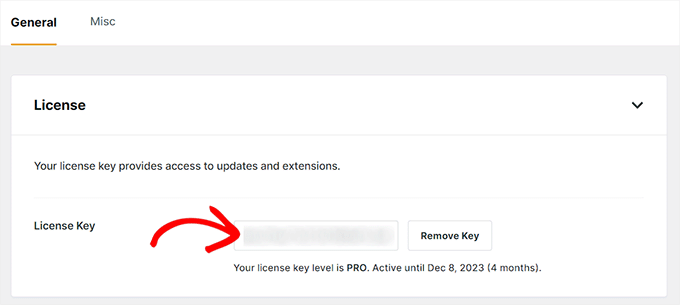
Now, the fuzzy search feature is not enabled in SearchWP by default.
However, you can easily turn it on by visiting the SearchWP » Settings page from the WordPress dashboard and scrolling down to the ‘General’ tab.
From here, simply toggle the switch next to the ‘Partial Matches’ option.
Doing so will enable the WordPress fuzzy search feature for your site, and your settings will be saved automatically.
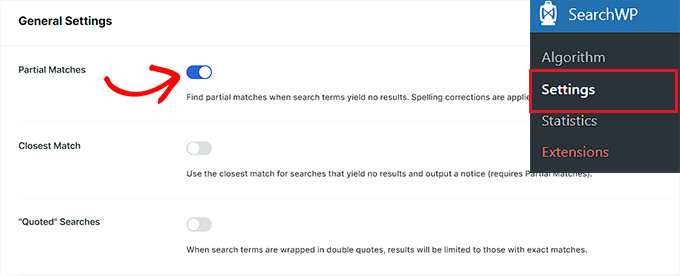
Once that is done, you should review the other SearchWP settings. The plugin has many powerful options that allow you to customize your blog’s search.
You can see them by going to SearchWP » Algorithm from the WordPress admin sidebar.
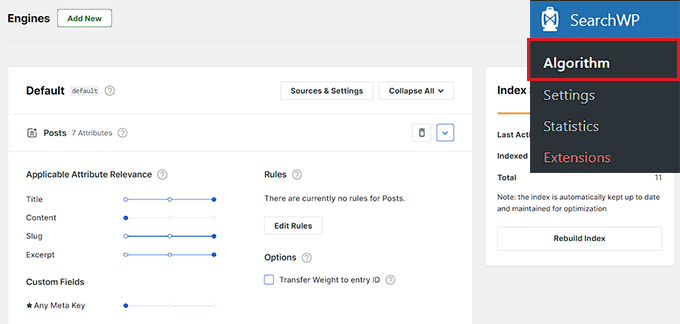
From here, you can assign weight to different search results. This tells SearchWP to consider some attributes as more important when displaying its search results.
You can also click on the ‘Sources & Settings’ button to select additional search areas. For instance, you can enable search for comments, products, custom post types, and more instead of simply posts and pages.
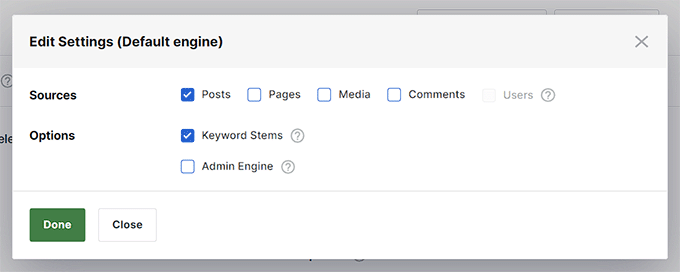
To learn more about these search settings, you can see our complete guide on how to improve WordPress search with SearchWP.
Adding a Search Form to Your Website
SearchWP automatically replaces the default WordPress search. This means that if you have already added the WordPress Search block or widget to your website, then it will start using the SearchWP custom algorithm for results.
However, if you have not added a search form to your website yet, then you can do so by simply inserting the Search block or widget into any post, page, or sidebar area.
Head over to the Appearance » Widgets page from the WordPress dashboard.
Here, click the add block ‘+’ button to find the Search block and add it to your sidebar. Then, don’t forget to click on the ‘Update’ button to store your settings.
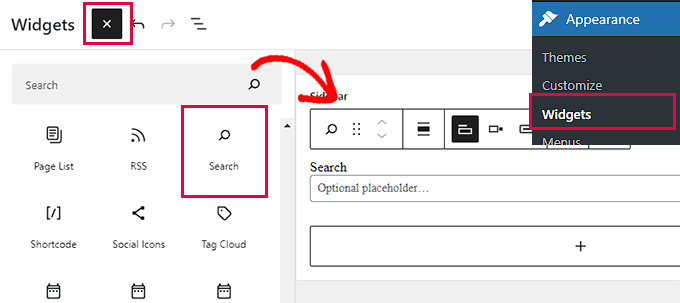
However, if you are using a block theme, then it may not have a widget-ready area. In that case, you won’t see the Widgets screen under the Appearance menu.
Instead, you can use the full site editor to add the search block to your website. Simply go to the Appearance » Editor page to launch the editor.
Here, click the ‘+’ button and add the Search block to where you want to display the search form on your website.
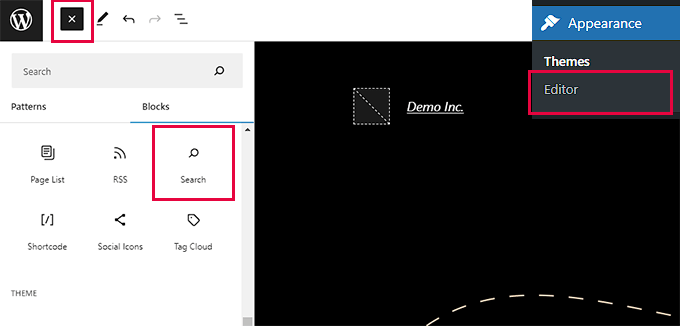
Don’t forget to click on the ‘Update’ button to save your settings.
You can now visit your website and try out the new, more powerful custom search feature.
For example, the image below shows how the fuzzy search feature returns multiple relevant results from a misspelled query on the search results page.

Bonus: Search by Category in WordPress to Improve User Experience
By adding fuzzy search, you make it easier for users to find relevant content, making your website more user-friendly and helpful for visitors.
Another way to make your WordPress site easier to navigate is by allowing users to search by category.
Categories allow you to organize the content on your website in a more structured way. If you have a lot of blog posts on your site, then allowing users to search by category makes it easier for them to search within specific topic areas, such as travel.

If you have an online store, then adding a category search for products also makes it easier for customers to find the items they are interested in buying. In turn, this can help increase sales.
You can easily improve user experience by enabling the category search feature using the SearchWP plugin. This creates an interactive form where users can filter results using the different categories on your site.
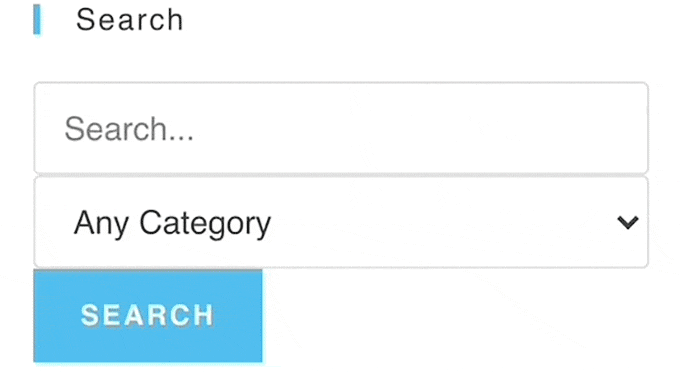
For more details, please see our tutorial on how to search by category in WordPress.
We hope this article helped you learn how to easily add fuzzy search to your WordPress website. You may also want to see our tutorial on how to add multilingual search in WordPress and how to add a search toggle effect in WordPress.
If you liked this article, then please subscribe to our YouTube Channel for WordPress video tutorials. You can also find us on Twitter and Facebook.





Dennis Muthomi
Thank you for this informative article. I especially liked the part about how SearchWP can find partial matches. As a website owner I’ve seen visitors misspell search terms by checking my site’s search logs to see what common misspellings are. Fuzzy search has been on my to-do list and this guide is a great step by step.
I’ll use the common misspellings from the logs and fine tune the fuzzy search settings for even better results.
Thanks for this WPBeginner!
Jiří Vaněk
This looks like a great option to make your search better. I can think of an alternative. Is there a plugin that would allow me to write alternatives to the article title? So not only an alternative with a typo, but also perhaps a headline but in a slightly different form, which the reader could search for on the website, but would not necessarily get results.
WPBeginner Support
At the moment we do not have a plugin or tool we would recommend for that.
Admin
Ralph
Very interesting solution, however price is too much. I understand no free trial and paying for plugins, it’s some people job. If this plugin could be 1 time only payment and not every year it would be nice.
Not a good use for personal blog due to price, but for bigger business it may be tool, that will change leads into conversions.
WPBeginner Support
Thanks for sharing your feedback
Admin
Dibyandu Pal
isn’t there any free solution for this??
WPBeginner Support
If we find one we would recommend we will be sure to update our article
Admin